Sikkim, a beautiful state in India, has many old and impressive temples that show its rich cultural history. This blog mentions the 8 famous temples in Sikkim. These temples are spread across the state and are a reminder of the region’s strong spiritual and architectural traditions. From intricately carved wooden structures to ornate stone buildings, each temple is a work of art that showcases the skill and dedication of the people who built them.
The temples in Sikkim are not only visually stunning but also hold great spiritual significance. Many of these temples are dedicated to various Hindu and Buddhist deities, and the local people respect them for their sacred importance. Visitors to Sikkim can explore these temples, learning about the region’s history and culture while being surrounded by a peaceful atmosphere.
1. Ganesh Tok
Ganesh Tok is a small but significant temple located on a hill in Gangtok, the capital of Sikkim. Dedicated to Lord Ganesha, the temple is known for its stunning panoramic views of the city and the surrounding hills. The temple’s interior is adorned with colorful prayer flags, adding to its serene ambiance. Visitors can enjoy the breathtaking views from the temple’s circular balcony, making it a must-visit destination for anyone traveling to Sikkim.
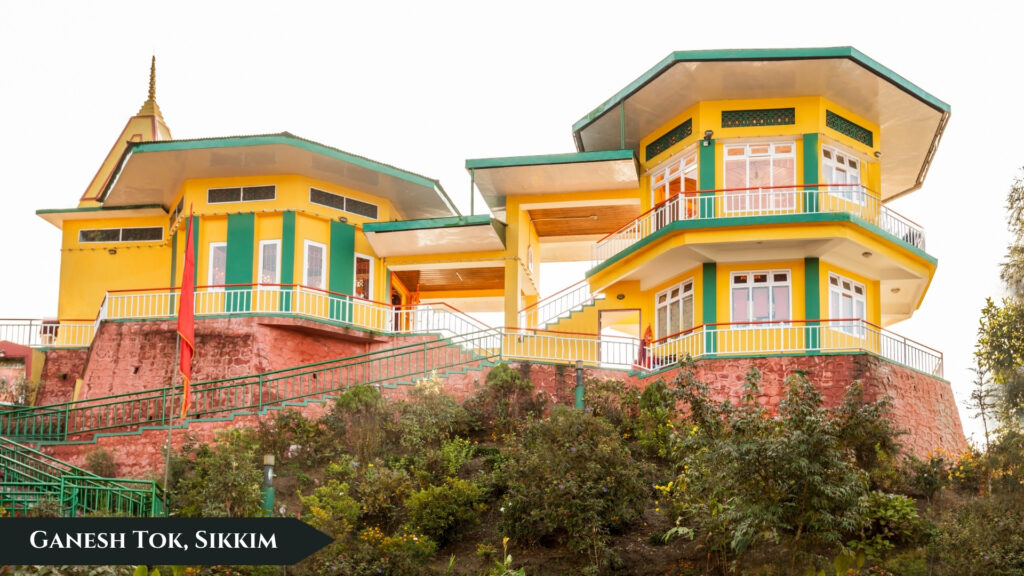
Significance of Ganesh Tok
Ganesh Tok is a small yet significant temple dedicated to Lord Ganesha, located on a hilltop in Gangtok. The temple offers panoramic views of the city and the majestic Kanchenjunga mountain range. It is believed that praying at Ganesh Tok fulfills one’s wishes and brings good fortune.
Local Beliefs Regarding Ganesh Tok
According to local legends, the place where Ganesh Tok stands was once inhabited by evil spirits. It was only after a sage meditated here that peace prevailed. The temple was established in 1952-53 by Shri Appa B Pant, the then Political Officer of Sikkim, and has since become a popular spiritual destination.
2. Hanuman Tok
Hanuman Tok is a sacred site located in the hills above Gangtok, dedicated to Lord Hanuman, the Hindu monkey god. The temple complex is visited by devotees from all over the country and offers a glimpse of the city and the beautiful hills and valleys surrounding it. The temple is managed by the Indian Army and is known for its serene ambience and stunning views of the Kanchenjunga mountain range.
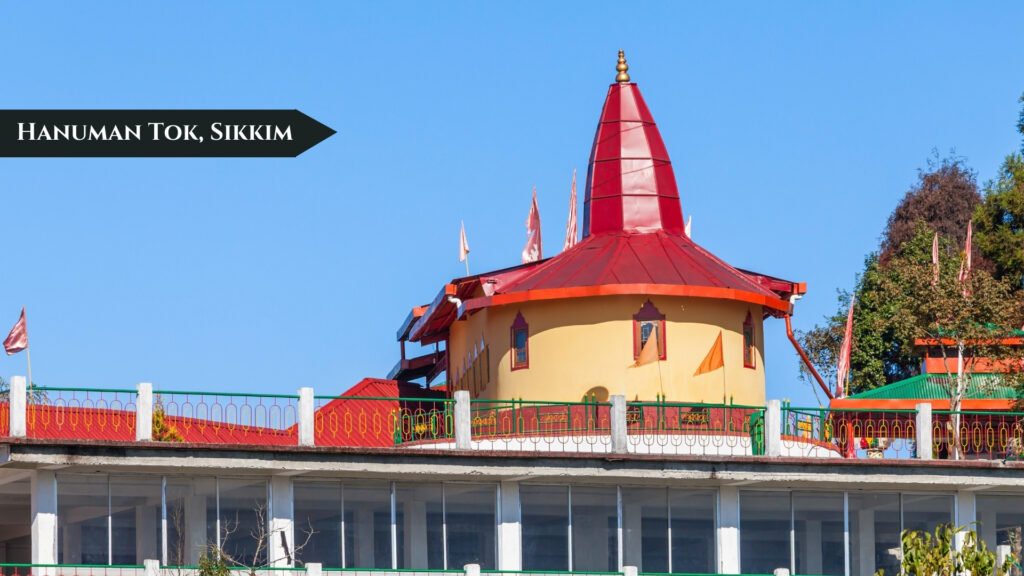
Significance of Hanuman Tok
Hanuman Tok is a revered temple complex dedicated to Lord Hanuman, located in the upper reaches of Gangtok. The temple is maintained by the Indian Army and is known as a wish-fulfilling shrine. It is believed that Lord Hanuman rested here while carrying the Sanjeevani herb to save Lord Rama’s brother Lakshmana.
Local Beliefs Regarding Hanuman Tok
Devotees strongly believe that sincere prayers offered at Hanuman Tok are answered by the divine. The temple’s serene ambiance and the panoramic views of the Kanchenjunga range add to its spiritual allure. The journey to the temple, adorned with colorful prayer flags, is as enchanting as the destination itself.
3. Baba Harbhajan Mandir
Baba Harbhajan Mandir is a remarkable temple located between Nathula and Jelepla pass at an elevation of 13,123 feet. The temple is dedicated to the spirit of Sepoy Harbhajan Singh, who vanished in 1971 and is believed to guide soldiers stationed in the high-altitude Eastern Himalayas. The temple is a testament to the bravery and sacrifice of the Indian Army and is a significant spiritual destination for those who visit Sikkim.

Significance of Baba Harbhajan Mandir
Baba Harbhajan Mandir is a unique shrine dedicated to Baba Harbhajan Singh, an Indian Army soldier who died near the Nathula Pass. The temple, located between Nathula and Jelep La pass, is believed to be blessed by Baba’s spirit, which is said to protect the soldiers stationed in the area.
Local Beliefs Regarding Baba Harbhajan Mandir
Many legends surround Baba Harbhajan Mandir. It is believed that Baba’s spirit warned the Indian soldiers of impending attacks during the Indo-China war. The water kept in the temple is considered sacred and is believed to have healing properties. Devotees also offer slippers at the temple, which are said to cure foot ailments.
4. Thakurbari Temple
Thakurbari Temple is one of the oldest Hindu temples in Sikkim, built in 1935 on land donated by a ruler of the Namgyal dynasty. Located in the heart of Gangtok, the temple is a symbol of the Chogyals’ tolerance for other faiths. The temple is home to all major Hindu deities and is a popular destination for devotees and tourists alike.
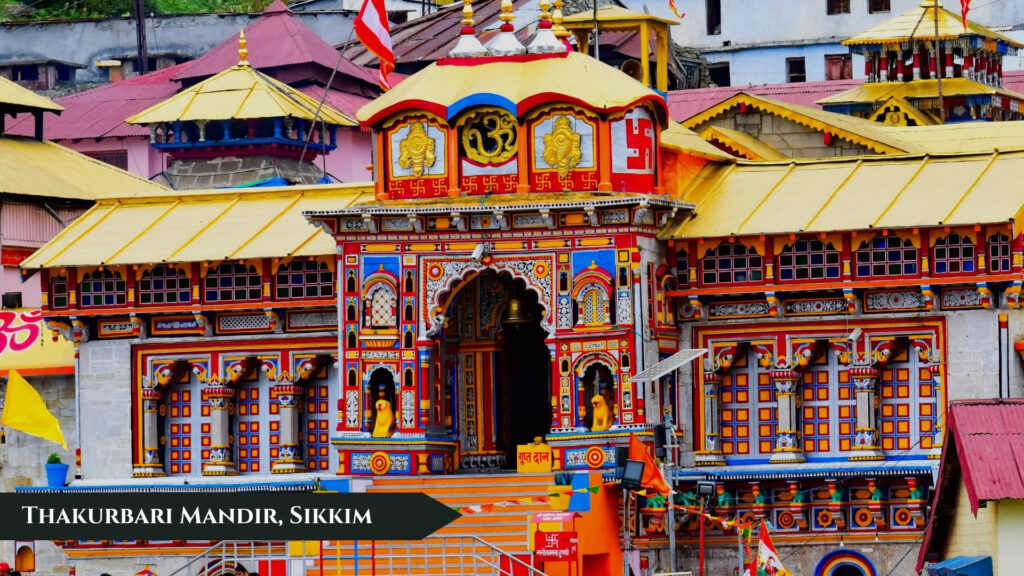
Significance of Thakurbari Temple
Thakurbari Temple, situated in the heart of Gangtok, is one of the oldest Hindu temples in Sikkim. Built on land donated by the Namgyal dynasty in 1935, the temple houses almost all major Hindu deities and is an important center of convergence for the Hindu community.
Local Beliefs Regarding Thakurbari Temple
The temple’s serene interior provides a stark contrast to the bustling town outside. Devotees from all over the country visit Thakurbari Temple to seek blessings. The temple organizes grand festivals and social events that attract visitors from far and wide.
5. Char Dham Temple
Char Dham Temple is a brand-new pilgrimage-cum-cultural center located on Solophok Hill in the southern region of Sikkim. The temple complex features a massive 26.15-meter-tall statue of Lord Shiva and replicas of the twelve Jyotirlingas and the four Dhams. The temple is a popular destination for tourists and devotees of Lord Shiva, offering a unique spiritual experience amidst peaceful nature.
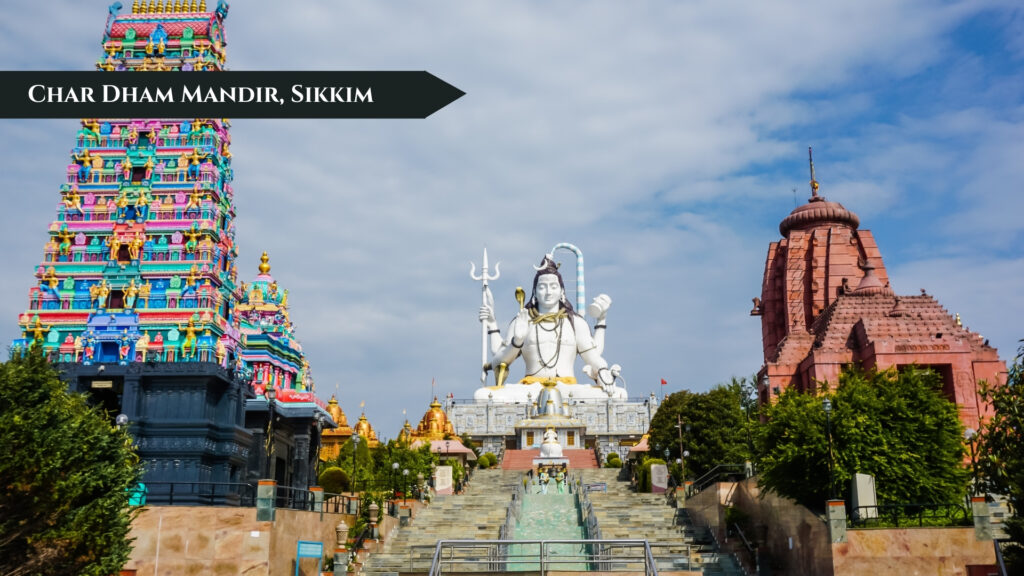
Significance of Char Dham Temple
The Char Dham Temple, also known as Solophok Char Dham, is a grand pilgrimage-cum-cultural center built to boost religious tourism in Sikkim. The temple complex houses replicas of the 12 Jyotirlingas and the four Dhams – Badrinath, Jagannath, Dwarka, and Rameshwaram.
Local Beliefs Regarding Chardham Temple
The main attraction of the Char Dham Temple is the towering 108-feet statue of Lord Shiva, visible from miles away. Devotees believe that visiting this temple is equivalent to visiting all the 12 Jyotirlingas and the four Dhams, making it a highly revered pilgrimage site.
6. Kirateshwar Temple
Kirateshwar Mahadev Temple is a major Hindu shrine located on the banks of the River Rangit, surrounded by verdant forests. The temple is dedicated to Lord Kirateshwar, a beautiful incarnation of Lord Shiva as a hunter. The temple is popular for its unique architecture and is believed to grant wishes to those who pray earnestly.
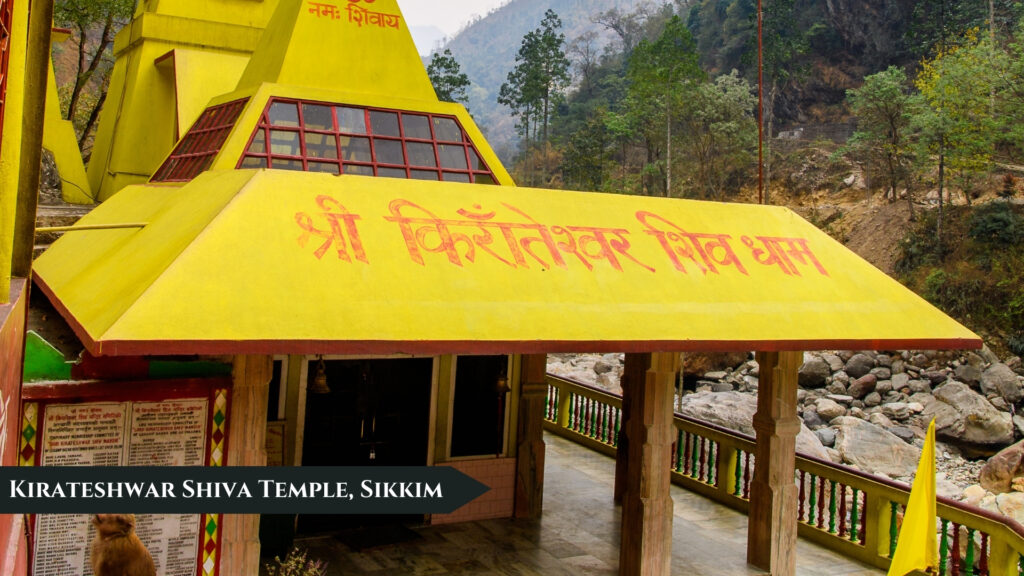
Significance of Kirateshwar Temple
Kirateshwar Mahadev Temple, located on the banks of River Rangeet in Legship, is one of the oldest temples in Sikkim dedicated to Lord Shiva. The temple is associated with the legend of Lord Shiva appearing before Arjuna in the form of a hunter or Kirat.
Local Beliefs Regarding Kirateshwar Temple
Devotees believe that sincere prayers at Kirateshwar Mahadev Temple can fulfill one’s wishes. The temple also houses shrines dedicated to Lord Rama and Goddess Durga. The festivals of Bala Chaturdashi and Maha Shivaratri are celebrated with great fervor here.
7. Vishwa Vinayak Temple
Vishwa Vinayak Temple is a Hindu temple dedicated to Lord Ganesha, located in Rhenock Rungdung, East Sikkim. The temple features 51 depictions of Lord Ganesha, including 16 statues standing at a height of 12 feet along the corridor leading to the main entrance. The temple is known for its massive mythological Daemon vs. Gods Samudra Manthan statues, adding to its dramatic and exciting atmosphere.

Significance of Vishwa Vinayak Temple
Shri Vishwa Vinayaka Mandir, located in Rhenock Rungdung, East Sikkim, is a grand temple dedicated to Lord Ganesha. The temple features 51 forms of Ganesha, with 16 of them standing at an impressive height of 12 feet along the entrance corridor.
Local Beliefs Regarding Vishwa Vinayak Temple
The temple’s main attraction is the massive mythological Samudra Manthan statues depicting the epic battle between the Devas and Asuras. Devotees also revere the Shivling and Hanuman statue installed within the temple premises.
8. Samdruptse Temple
Samdruptse Temple is a famous temple located on Samdruptse Hill, near Namchi in Sikkim. The temple complex features a giant statue of Lord Shiva at its center and is known for its peaceful atmosphere. The temple is visited by thousands of Hindu devotees every year and offers a unique spiritual experience amidst the stunning natural beauty of Sikkim.
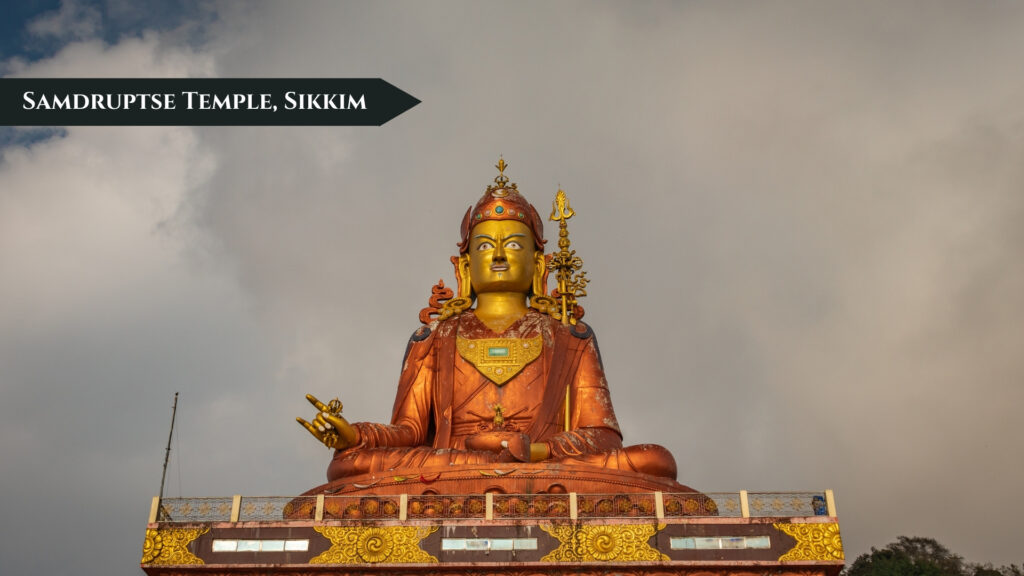
Significance of Samdruptse Temple
Samdruptse Hill, located near Namchi, is home to the magnificent Samdruptse Temple featuring a 45-meter tall statue of Guru Padmasambhava, the patron saint of Sikkim. The statue, gilded in gold, is an engineering marvel that took seven years to construct.
Local Beliefs Regarding Samdruptse Temple
The hill on which the statue stands is believed to be a dormant volcano that can only be pacified through prayers. Monks offer their reverence and devotion to keep the volcano calm. The temple complex also houses a repository of rare historical photographs of Sikkim.
Importance of Temples In Sikkim
Temples in Sikkim are not just places of worship but also symbols of the state’s rich cultural heritage. They serve as spiritual centers that bring together people from different walks of life. The temples’ architecture, intricate carvings, and serene ambiance create an environment conducive to meditation and self-reflection.
Conclusion
Sikkim’s temples are a testament to the state’s deep-rooted spirituality and cultural diversity. From ancient shrines to modern marvels, each temple has its own unique story to tell. A visit to these sacred sites is not just a religious experience but also a journey of self-discovery amidst the breathtaking beauty of the Himalayas.
FAQs Related To Temples In Sikkim
1. What is the best time to visit temples in Sikkim?
The best time to visit temples in Sikkim is from March to June and September to November when the weather is pleasant and ideal for sightseeing.
2. Are there any dress codes to follow while visiting temples in Sikkim?
It is advisable to dress modestly while visiting temples in Sikkim. Avoid wearing shorts, sleeveless tops, or any revealing clothing as a sign of respect.
3. Can I take photographs inside the temples?
Photography rules may vary from temple to temple. It is best to seek permission from the temple authorities before taking any photographs, especially inside the main sanctum.
4. Are there any entry fees for visiting temples in Sikkim?
Most temples in Sikkim do not charge any entry fees. However, some may have a nominal fee for parking or camera usage.
5. Can I combine temple visits with other tourist attractions in Sikkim?
Yes, most temples in Sikkim are located close to other popular tourist attractions like viewpoints, monasteries, and parks. You can easily combine your temple visits with other sightseeing activities.




